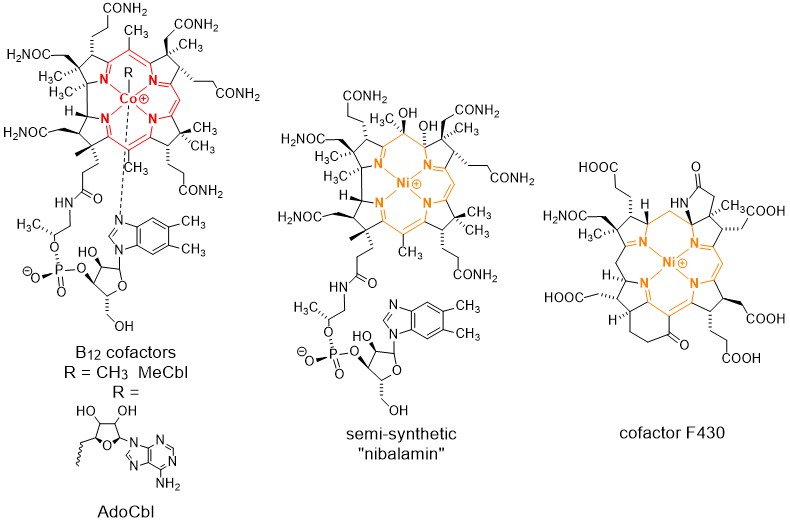A Novel Ni-containing B12 Derivative – Elucidating the Origin of Corrinoid and Corphinoid Cofactors
For a better understanding of biological processes catalyzed by transition metal complexes with porphinoid ligands, it is important to discern why different structural alterations of one ligand system were chosen by nature in order to accommodate a specific metal center. Some important porphinoid cofactors that display a high structural complexity are the B12 cofactors methylcobalamin (MeCbl) and 5’-deoxyadenosylcobalamin (AdoCbl), as well as cofactor F430. While the two former cofactors, derived from vitamin B12, play important roles in the metabolism of methionine and folate, nucleotide synthesis[1] and the breakdown of odd fatty acids,[2] the latter (“F430”) is found only in methanogenic bacteria where it catalyzes the formation – as well as the oxidation – of methane.[3] Recently we accomplished the first partial chemical synthesis of a cobalamin derivative starting from vitamin B12, that contains a central nickel ion instead of cobalt. Key step of the synthetic route was the simultaneous demetallation and ring closure of a ring-opened 5,6-seco-cobalamin. The resulting ‘nibalamin’ derivative shares spectroscopic features with F430 that are attributed to structural similarities of the tetradentate ligand framework.[4]

The coordination chemistry of this hybrid F430–B12 species, however, supports pioneering work of the Eschenmoser group regarding why nature has combined Ni with a corphin rather than a corrin ligand in F430 to allow for challenging biochemical transformations.[5] Semi-synthetic metallocorrins can shed new light on the old question of corrin vs. corphin ligand in nature but might as well bear potential for applications in analytical and medicinal science. Financial support by the Forschungskredit of the University of Zurich (grant FK-17-088) is gratefully acknowledged.
[1] R. Banerjee, S. W. Ragsdale, Annu. Rev. Biochem. 2003, 72, 209–247. [2] R. Banerjee, Chem Rev 2003, 103, 2083–2094. [3] A. Pfaltz, D. A. Livingston, B. Jaun, G. Diekert, R. K. Thauer and A. Eschenmoser, Helv. Chim. Acta 1985, 68, 1338–1358. [4] C. Brenig, L. Prieto, R. Oetterli and F. Zelder, Angew. Chem. Int. Ed. 2018, 57, 16308–16312. [5] A. Eschenmoser, Angew. Chem. Int. Ed. 2011, 50, 12412–12472.